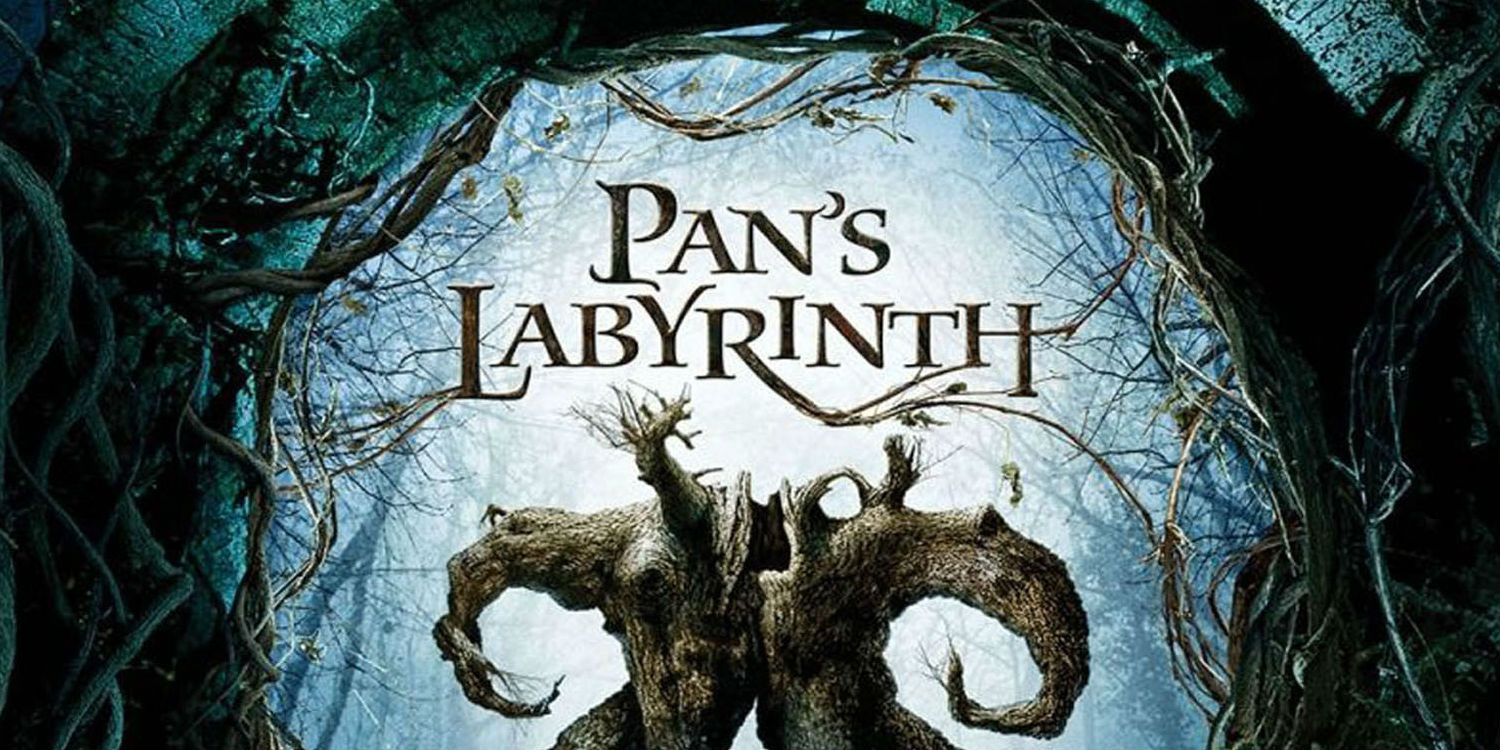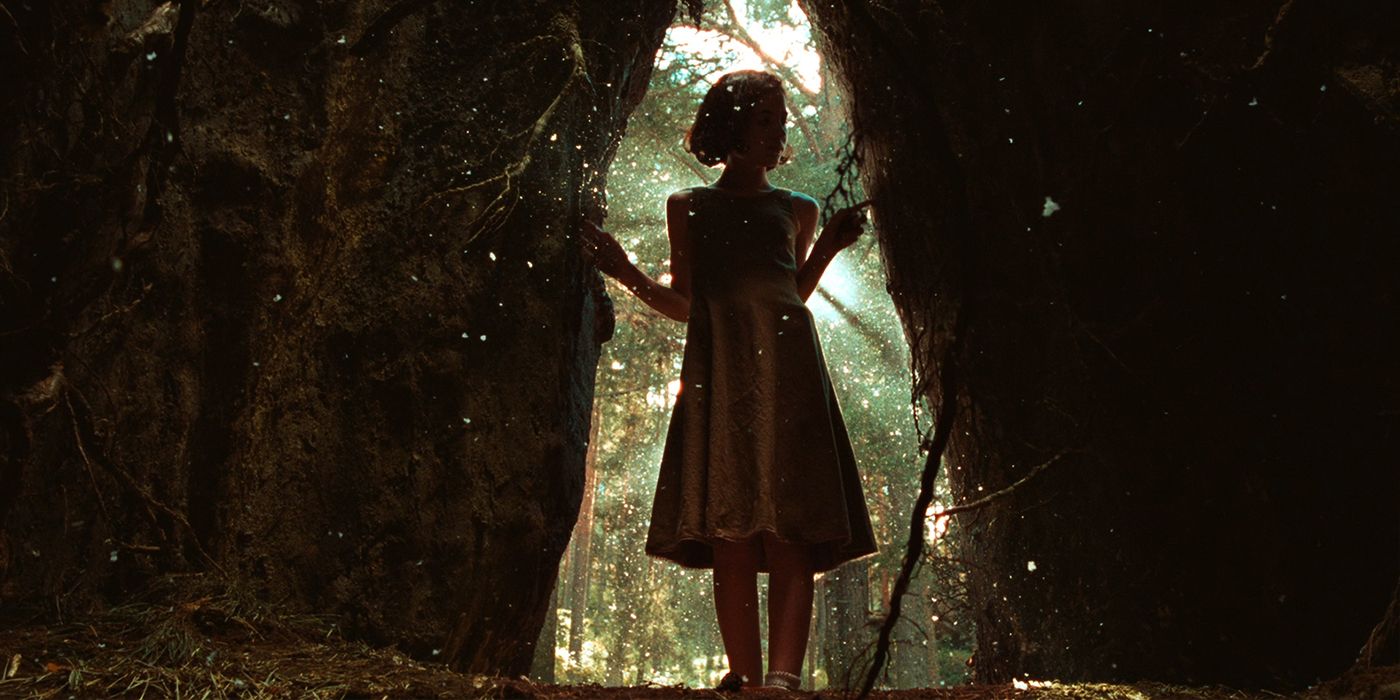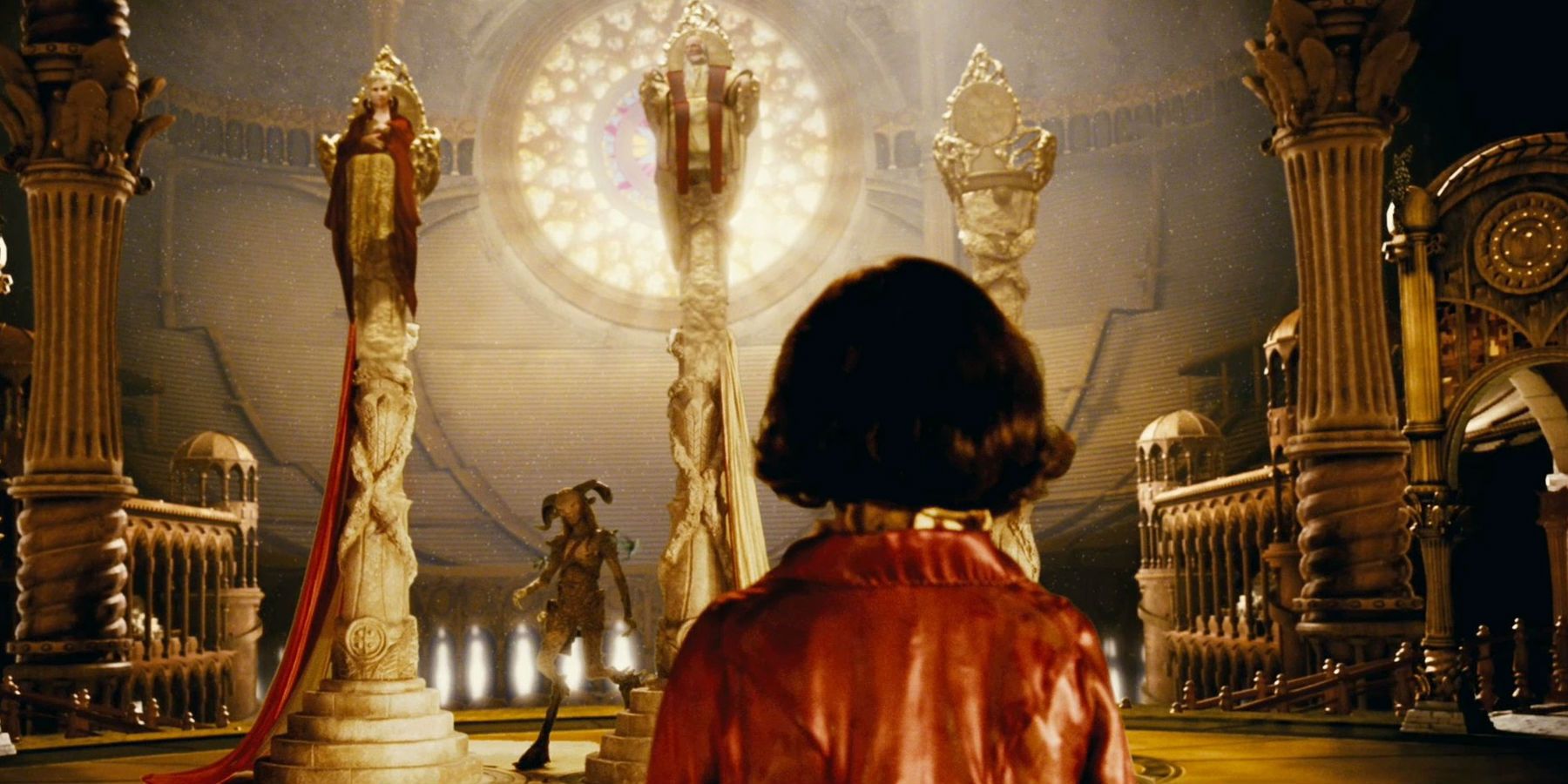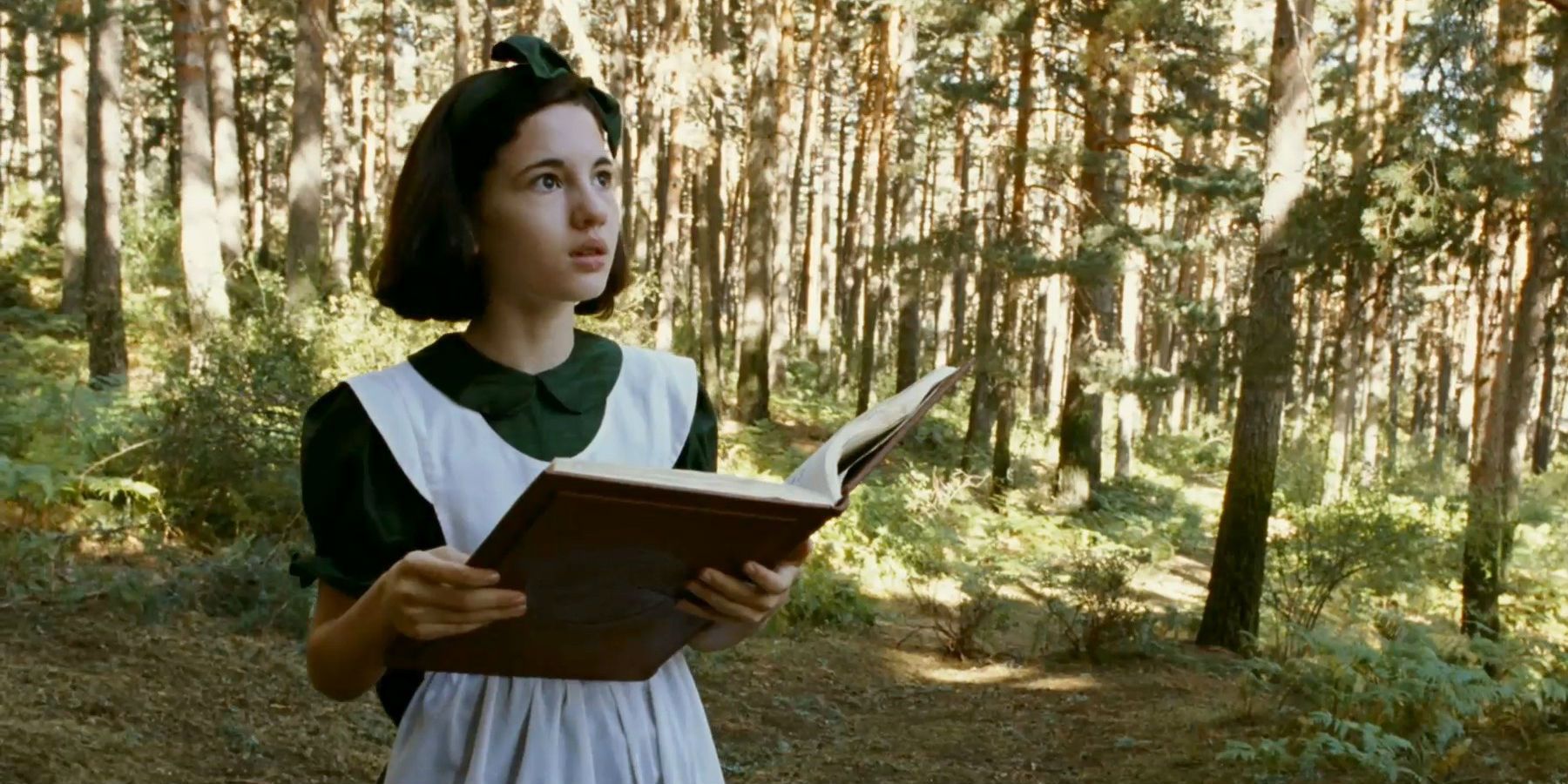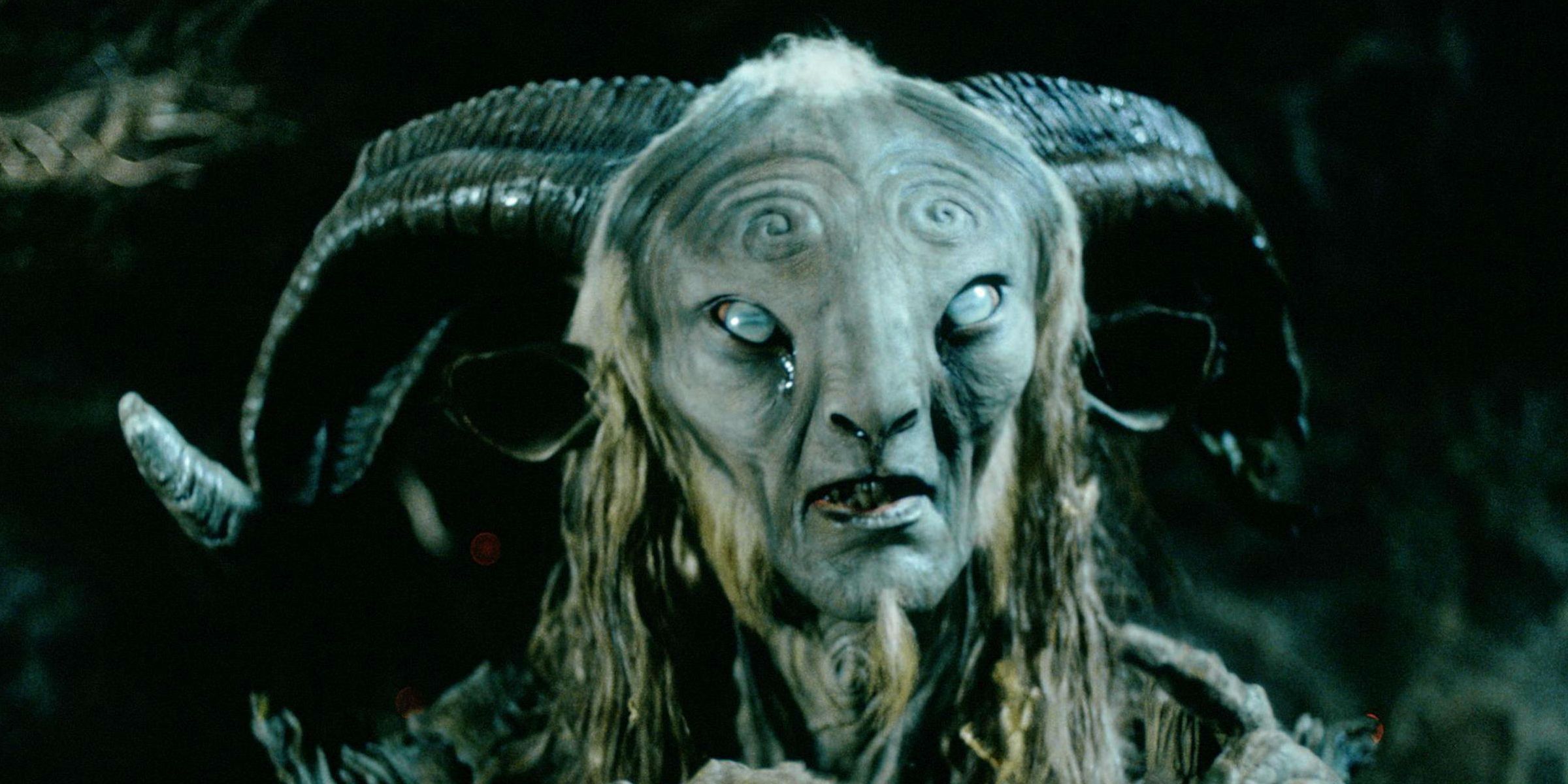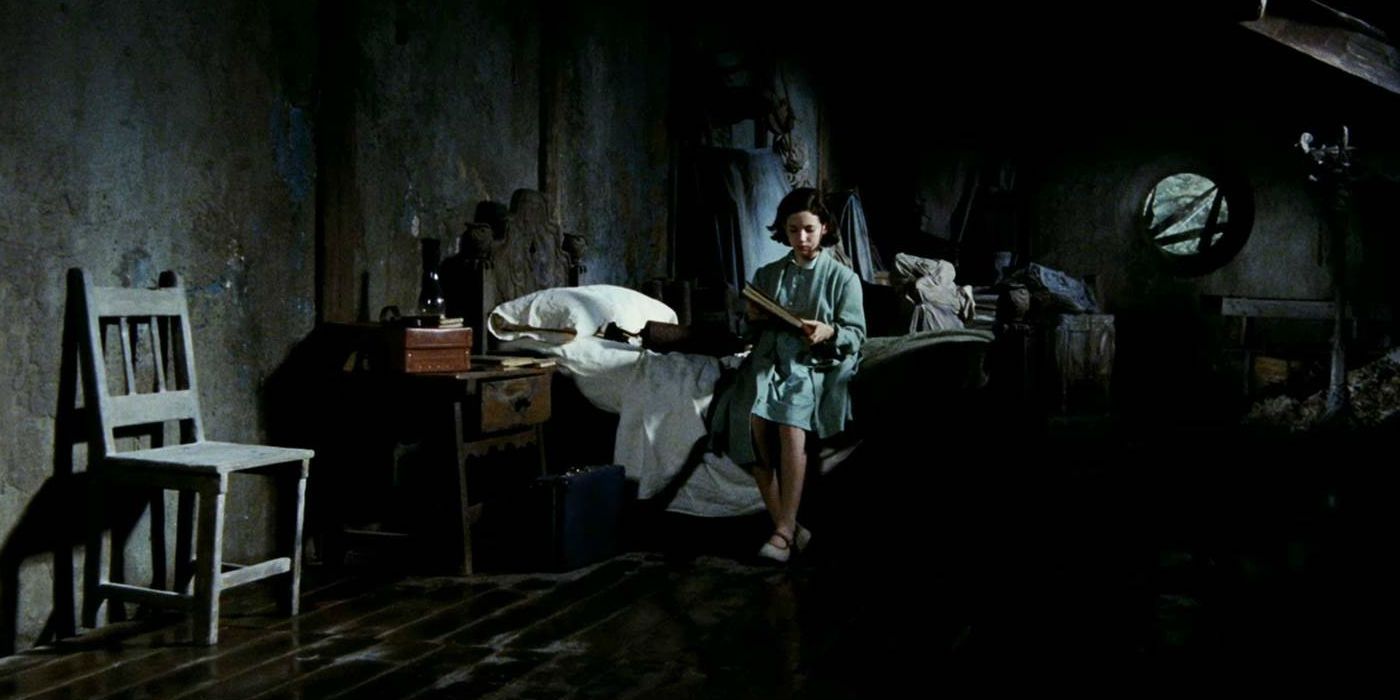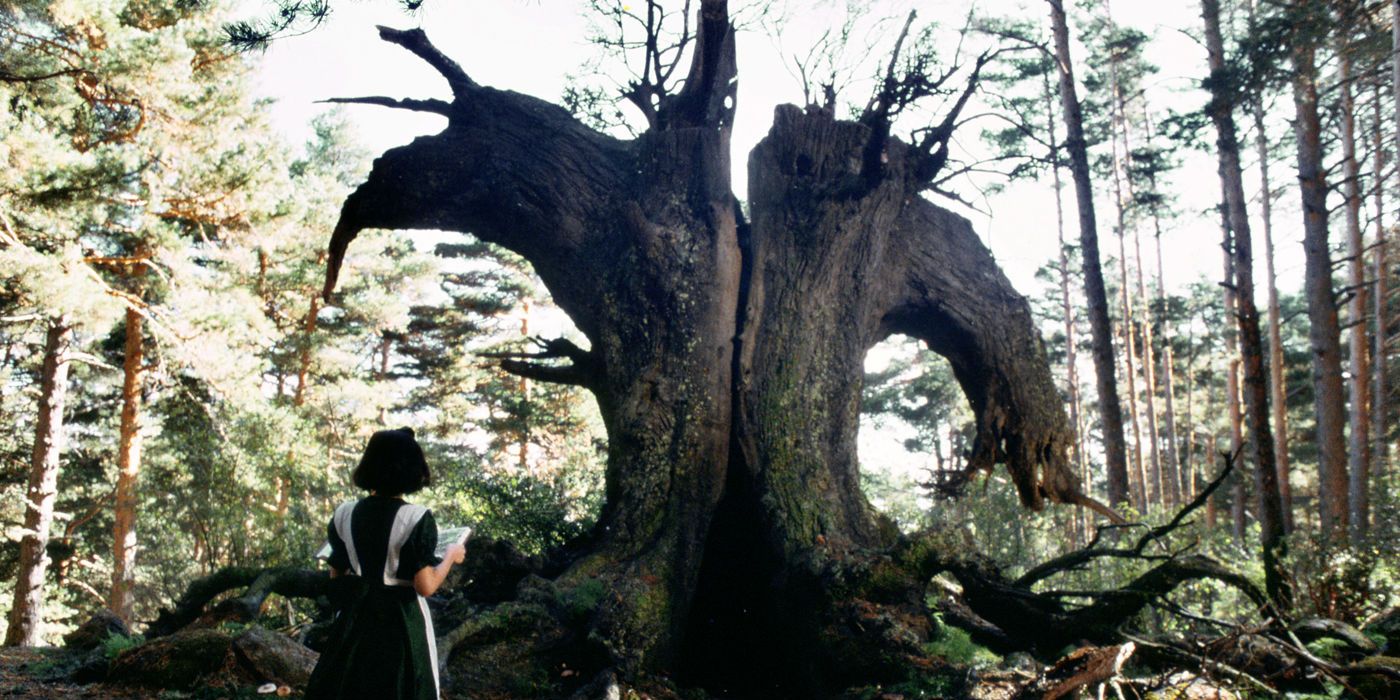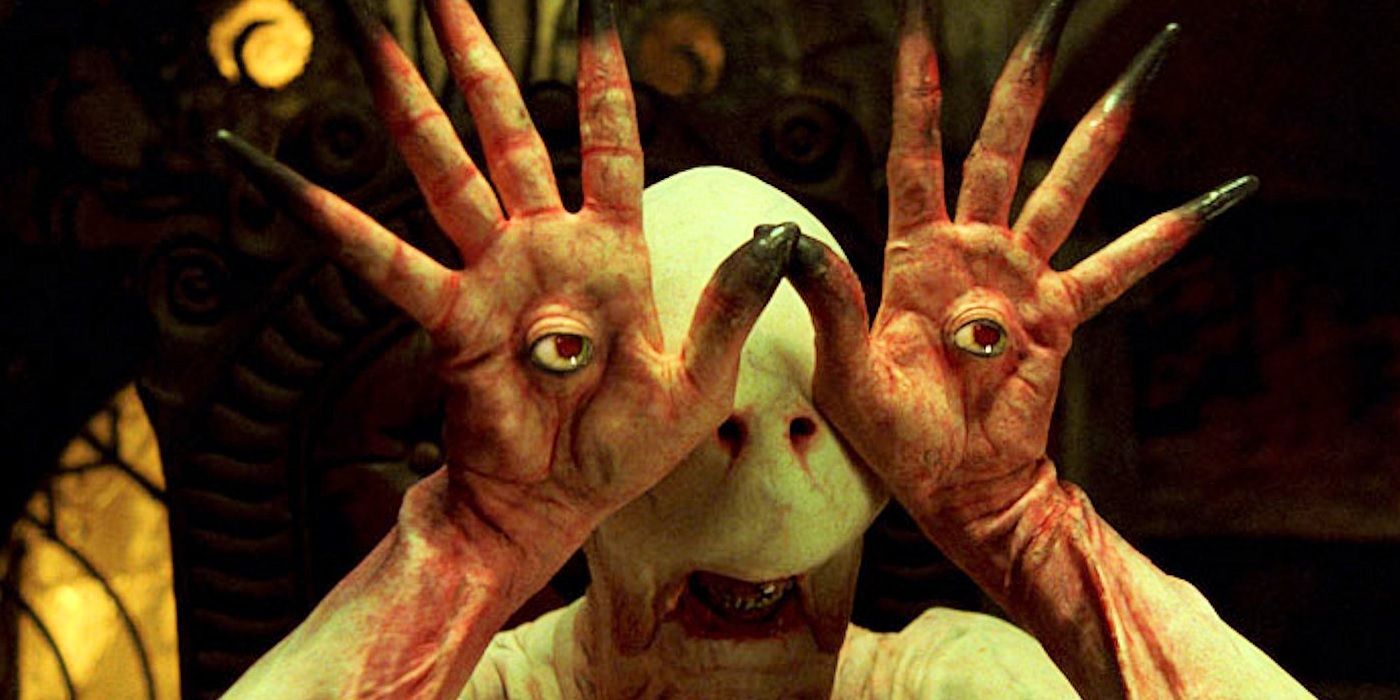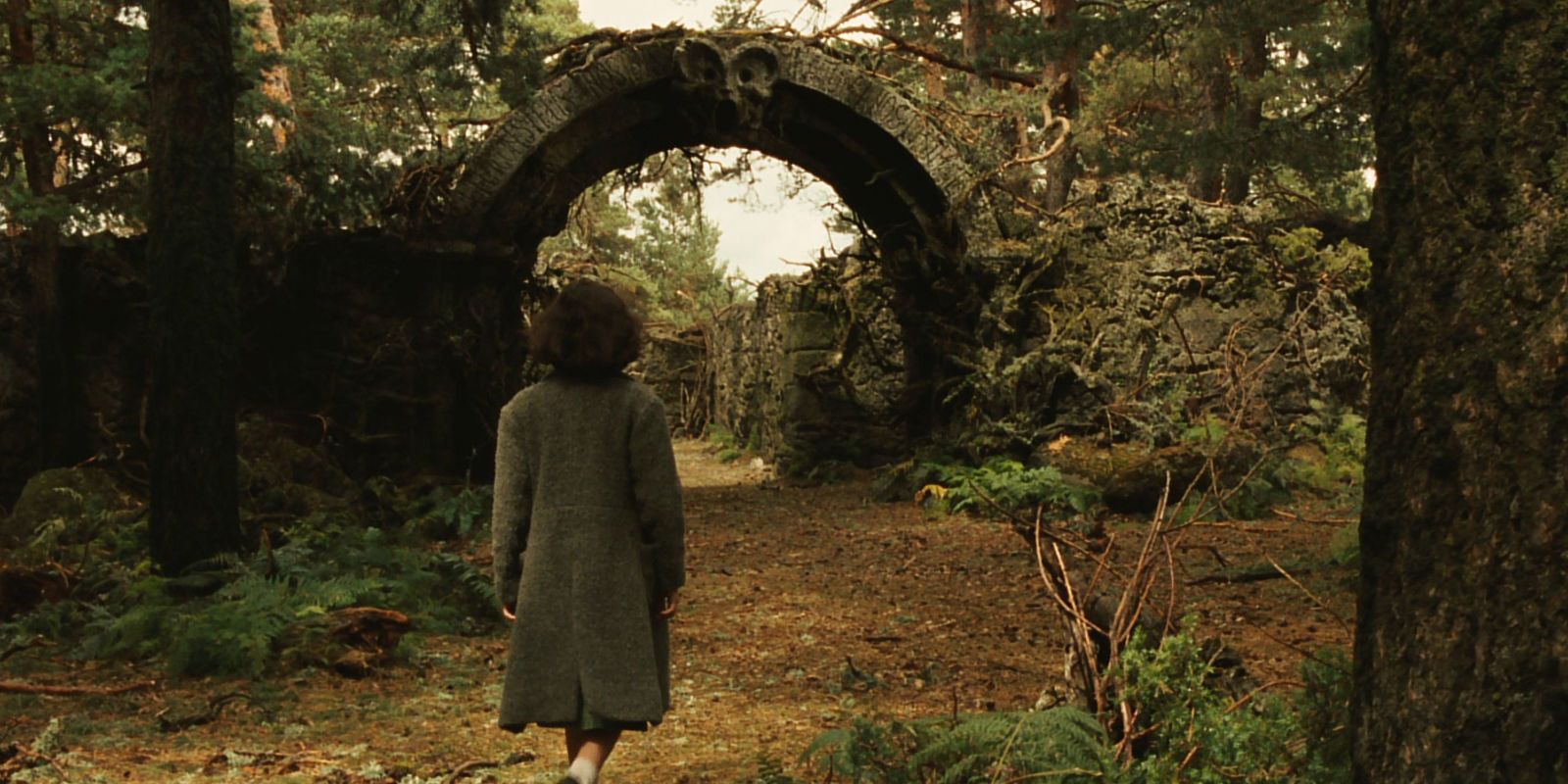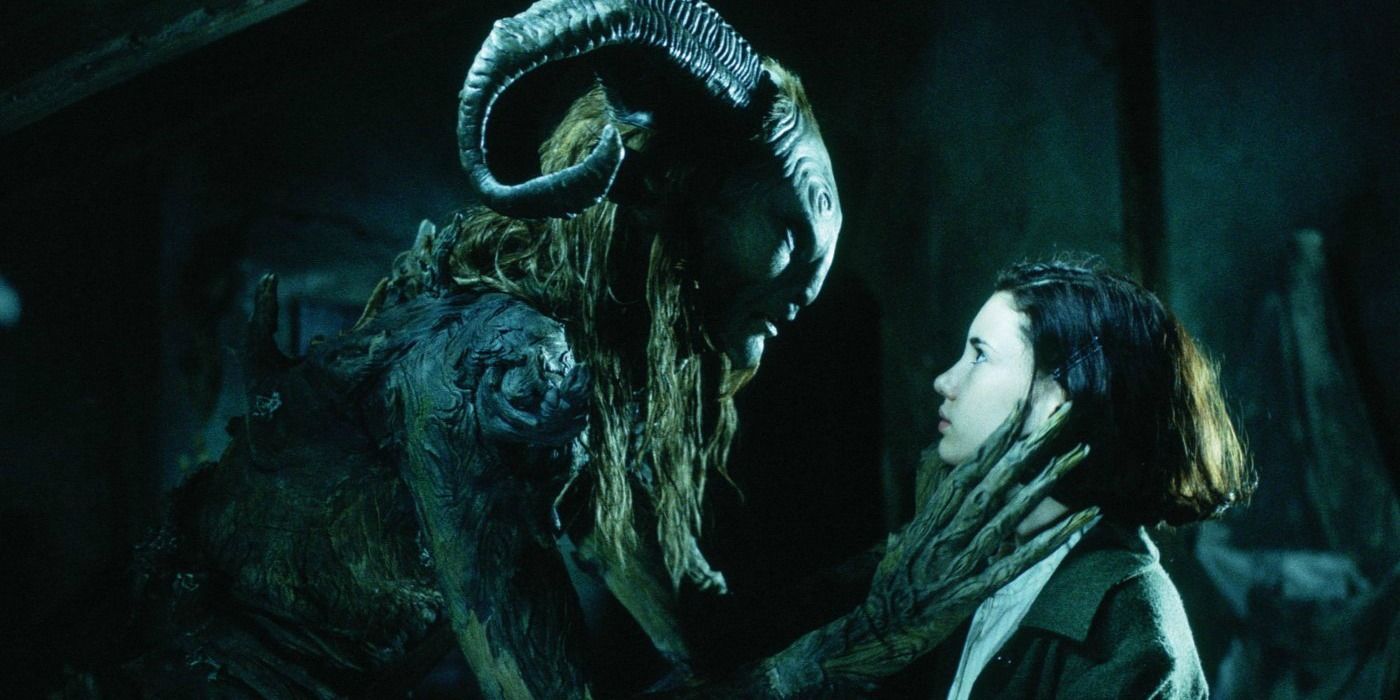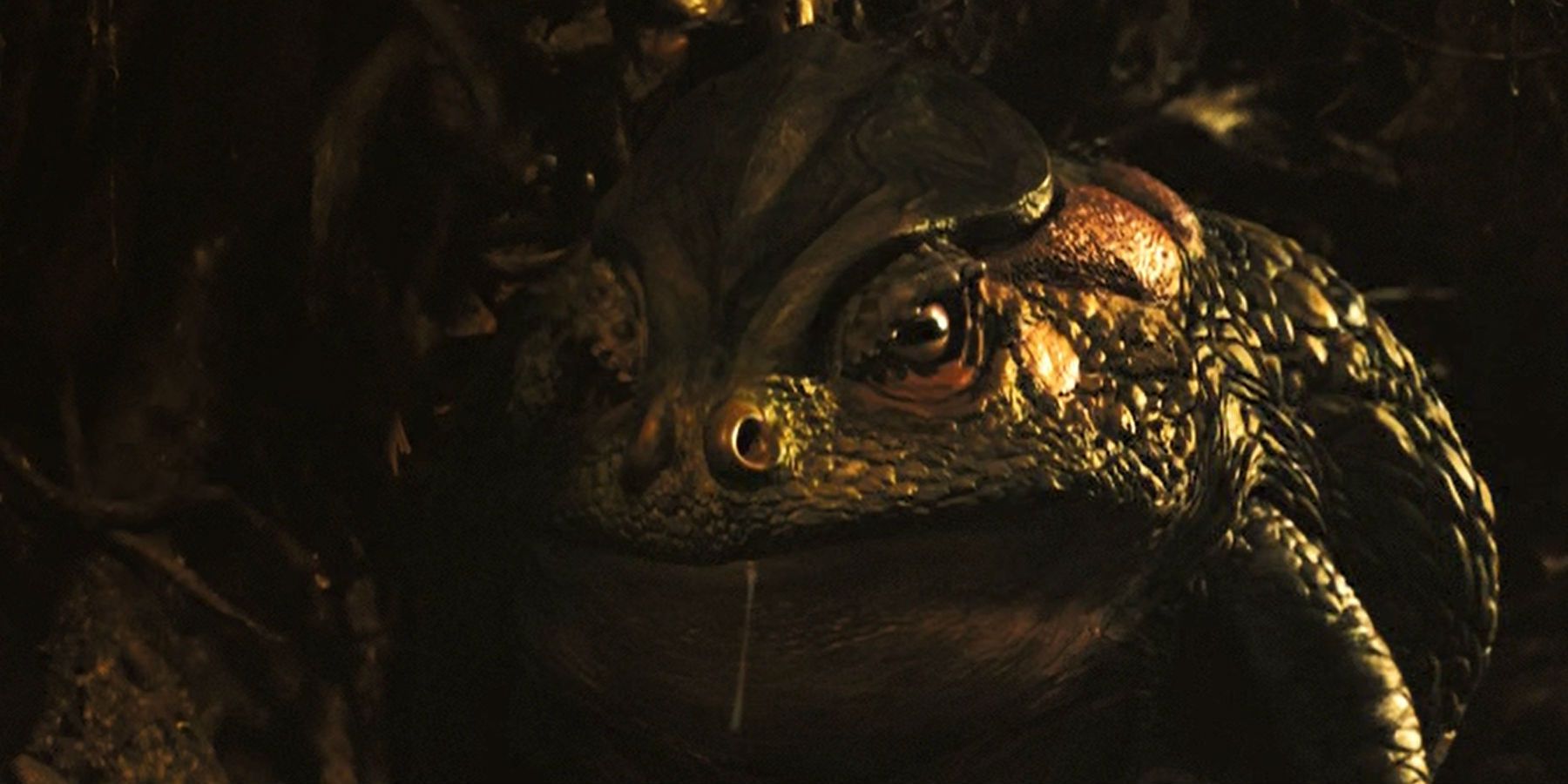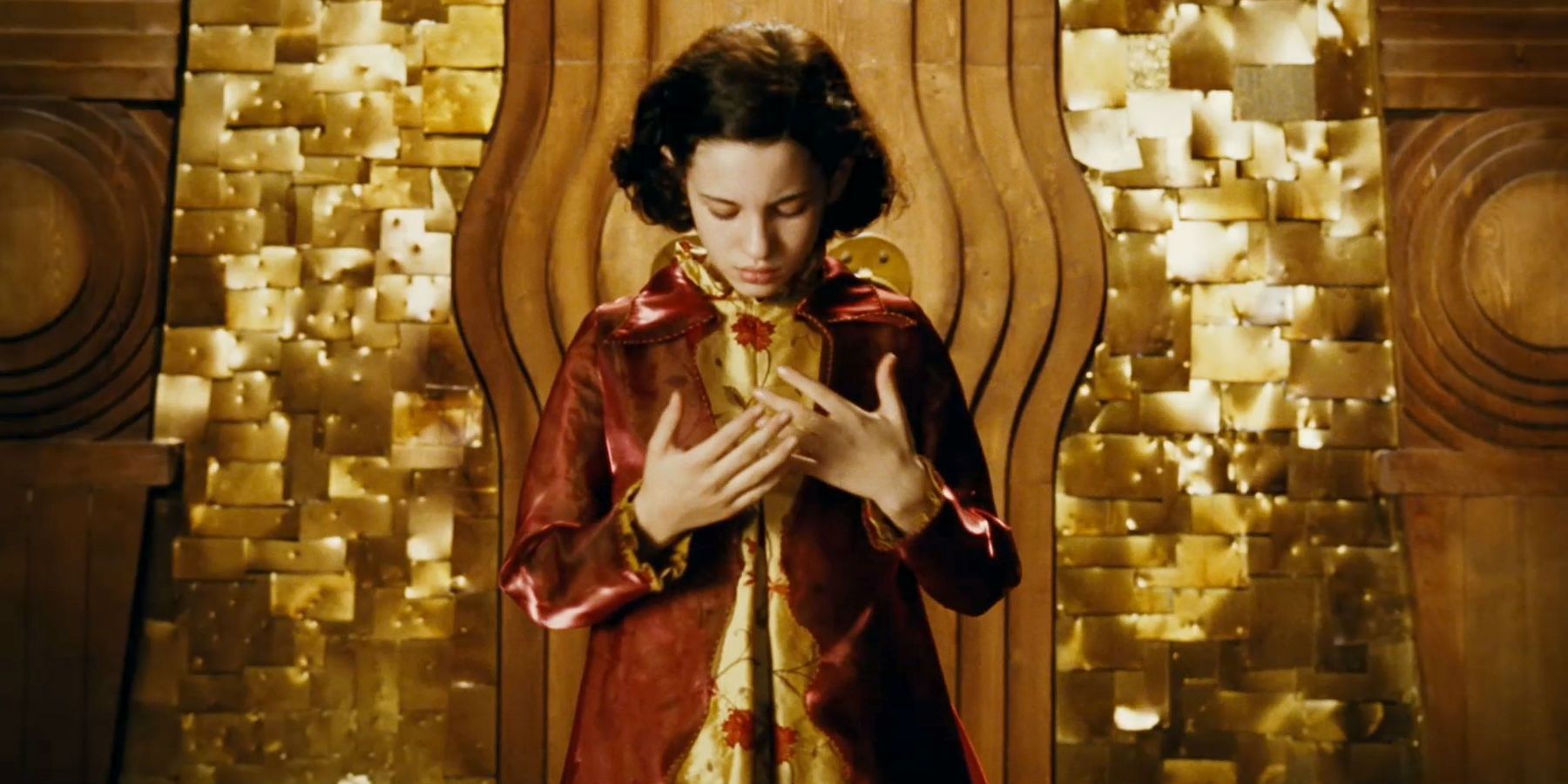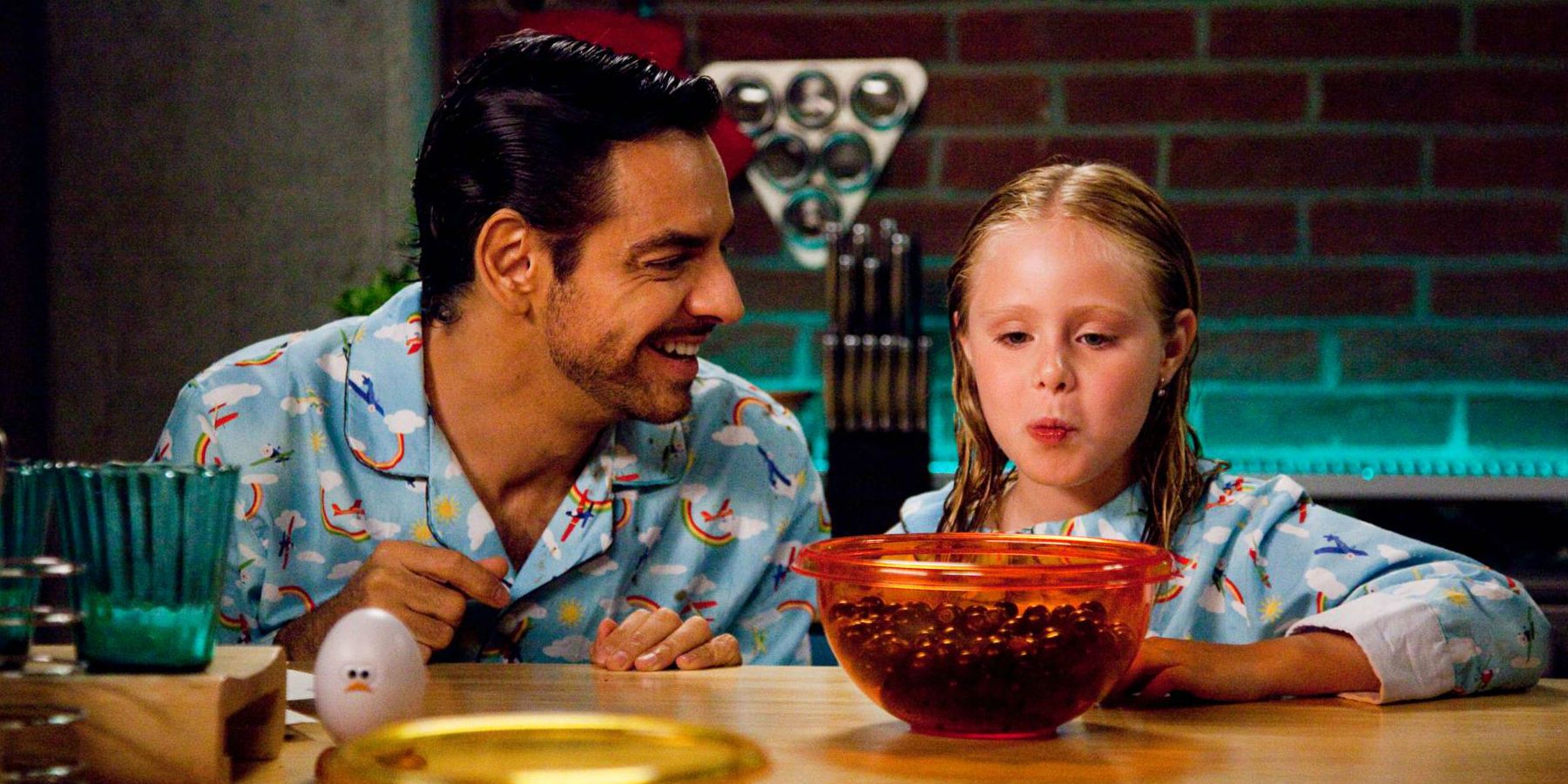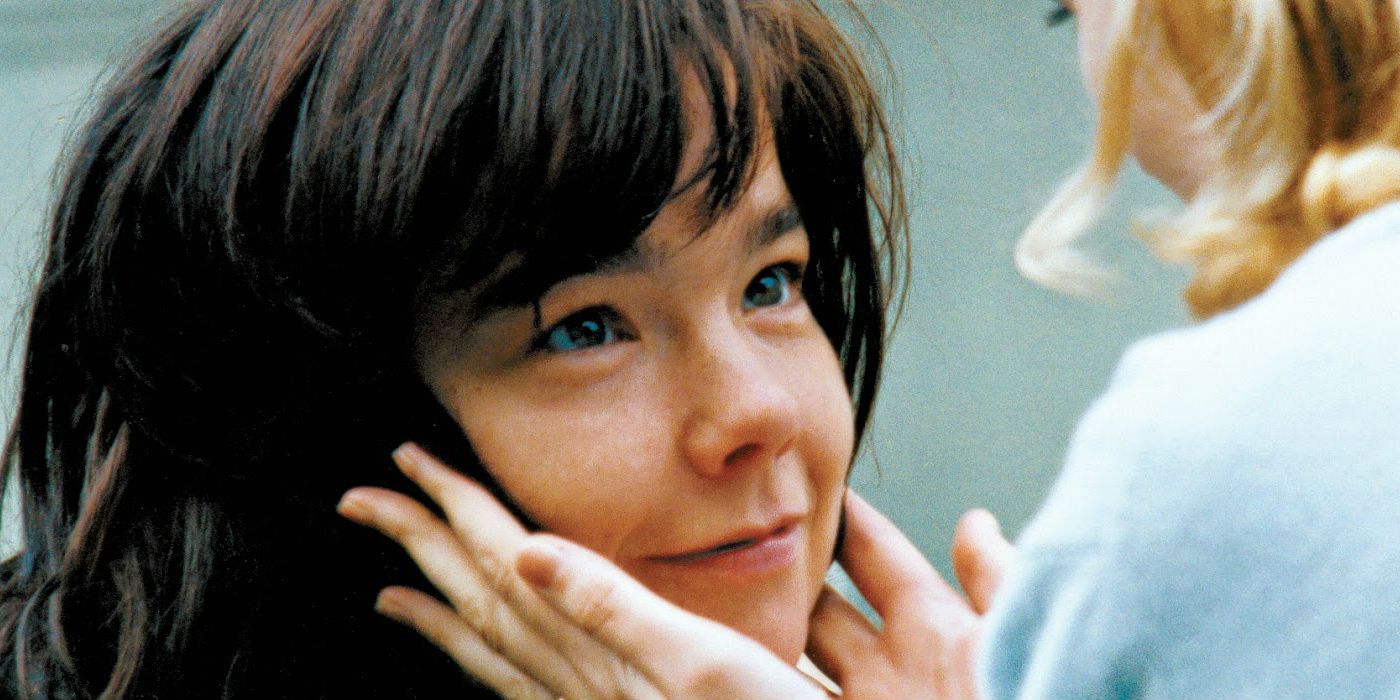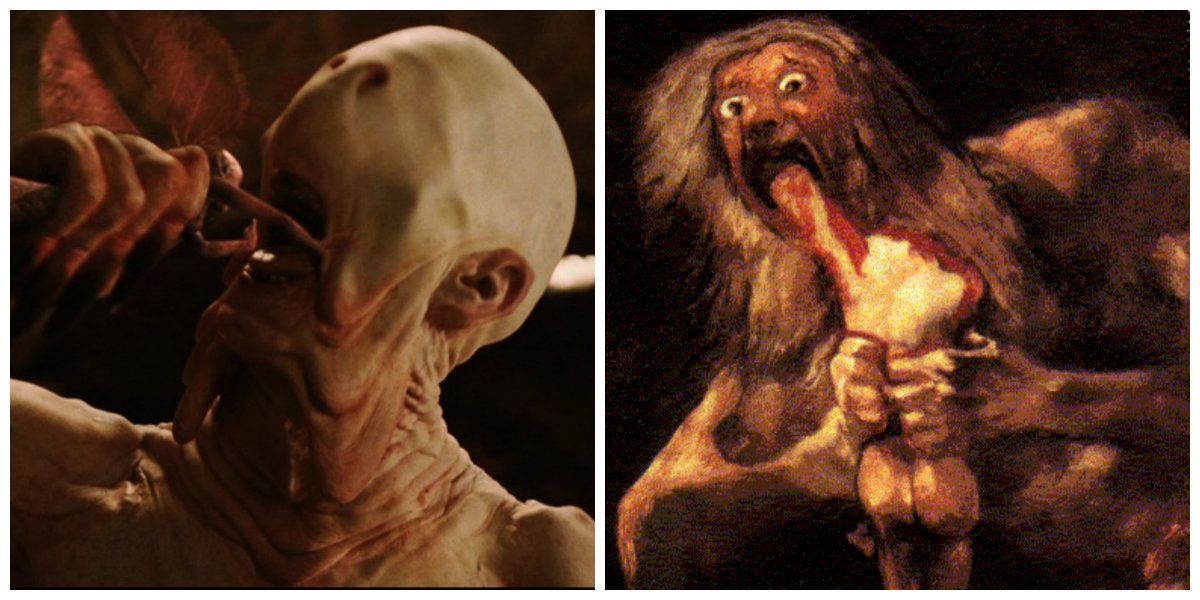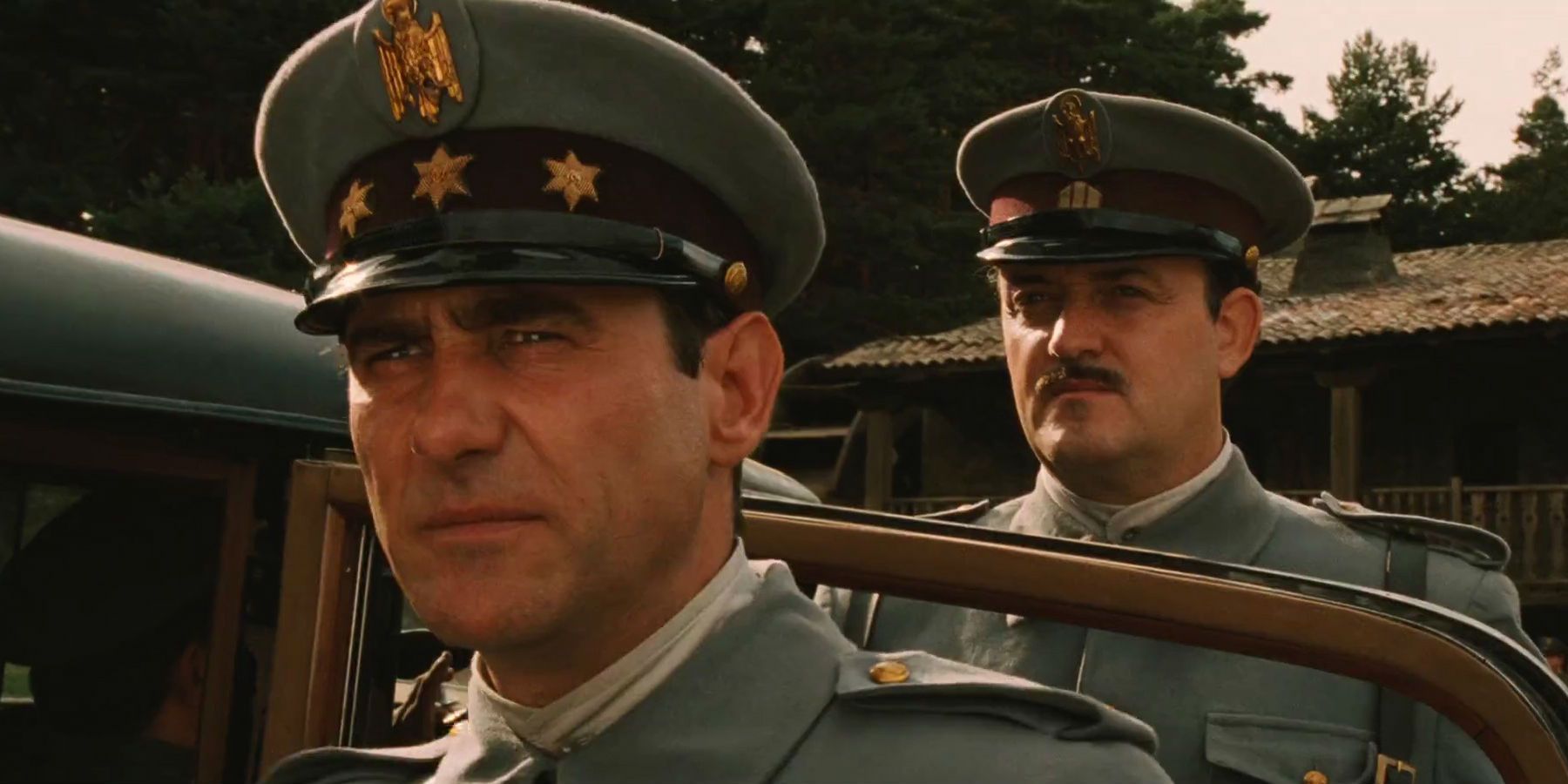Pan's Labyrinth is considered by many to be Guillermo del Toro's best film. The movie takes place in 1944, five years after the Spanish Civil War. A little girl named Ofelia (Ivana Baquero) journeys with her mother to meet her new stepfather, the sadistic and volatile Captain Vidal (Sergi Lopez). His job is to hunt down rebels who may be hiding in the woods. Frightened by the things she sees taking place around her, Ofelia retreats into a fantasy world, wherein a creepy faun (Doug Jones), believing her to be a reincarnated princess, assigns her three tasks that he claims will grant her immortality if completed.
The movie received extraordinary critical acclaim and was a solid box office hit. It's one of the best, most thematically substantive fantasy films of the last twenty years -- and possibly of all-time. The captivating visuals and rich storytelling ensure that you can watch Pan's Labyrinth again and again, seeing something new each time. Few films can boast that. Because we here at Screen Rant are huge fans, we now present some trivia about this amazing movie that we hope you will enjoy hearing about.
Here are 15 Things You Didn't Know About Pan's Labyrinth.
15. America is one of the very few countries where it's called Pan's Labyrinth
Pan is a famous figure in Greek mythology. He is the god of the wild, notable for being half-human, possessing horns and legs similar to those of a goat, and hanging out with Nymphs. Perhaps somewhat obviously, he can also play a pretty mean pan flute. As if that didn't make him fascinating enough, Pan achieved some renown for his sexual prowess. The faun who appears in Pan's Labyrinth is not Pan, though. He is named, appropriately, Faun. So what's the deal with Pan, then?
The answer is that Faun, or "Fauno" as he's referred to in the Spanish-language film, isn't really a name that has a lot of connotations for American audiences. Pan, on the other hand, at least calls to mind some basic qualities that the movie's character has. That's why America is one of the very few places where the picture is titled Pan's Labyrinth. (France also used the Pan reference.) It provides an inkling of what the story will involve in a way that registers with viewers on our shores. The actual title is El Laberinto Del Fauno (a.k.a. Faun's Labyrinth). Almost every other country where the movie was released used Fauno.
14. Four years of ideas for the film were left in a cab
Imagine pouring years of work into a project, only to lose it in a freak accident. That nearly happened to del Toro. The filmmaker has scores and scores of notebooks in which he writes notes about his projects and draws sketches of visual ideas for them. They are the heart and soul of his work. For Pan's Labyrinth, he had one such journal, which he nearly lost.
The director was riding in a British cab. He hopped out, unknowingly leaving the notebook, which had four years' worth of detailed plot and character information, in the back seat. Realizing his error as the cab was pulling away, he tried and failed to catch up with it. Luckily for him -- and us -- the cab driver found the journal, as well as the piece of stationary from a local hotel that had been tucked inside. The cabbie took the book to the hotel, where management was able to determine its rightful owner. A grateful del Toro gave the driver a nice fat tip for his kindness. This “miracle” convinced the director that making Pan's Labyrinth was definitely in the cards.
13. The script was rewritten to accommodate the lead actress
Spanish actress Ivana Baquero has the lead role of Ofelia in Pan's Labyrinth. It's a highly layered part that would challenge any seasoned performer because it requires the display of many very intense emotions, as well as the need to convey thoughts and feelings that the character is hiding. The amazing thing is that Baquero, who totally nails these requirements, was only eleven years old when she portrayed Ofelia.
Her casting was essentially an accident. Guillermo del Toro was actually looking to cast a younger actress, probably one who was about eight. When Baquero, who was ten at the time, showed up to audition, she blew away the director and his pre-production crew. Del Toro was so impressed by her talent – and he wanted her for the role so badly – that he re-wrote the screenplay to make Ofelia a couple of years older than she was initially intended to be. The rest, as they say, is history.
12. Doug Jones had to learn Spanish for the movie
Doug Jones has a rather unique resume. As an actor and contortionist, his ability to move in weird, unusual ways got him cast as a zombie in Disney's Hocus Pocus and as a clown in Tim Burton's Batman Returns before teaming up with del Toro for Mimic and Hellboy (the latter of which cast him as fishman Abe Sapien, the role for which he's best known).
With Pan's Labyrinth containing some creepy creatures, the director knew he needed to have Jones come on board the project to play both the Faun and the Pale Man. There was only one hitch: Jones, an American, didn't speak Spanish, and the entire film was going to be in del Toro's native language. The actor didn't want to just repeat words phonetically. He wanted them to sound natural and have meaning. Because the makeup process used to turn him into these characters took about five hours a day, Jones used this time to learn how to speak his lines with accuracy and authenticity. Unfortunately for him, del Toro ended up dubbing his voice for the finished product. Still, the commitment to authenticity benefited the movie by making the dubbing process smoother.
11. Guillermo del Toro refused to make it in Hollywood
Guillermo del Toro's 1997 movie Mimic was an exercise in frustration for him. It was his first studio film, and he was working for Bob Weinstein, who, like his more famous brother Harvey, was well-known for being difficult and demanding. The two clashed over many creative aspects of Mimic, which led to GDT's preferred cut getting scrapped in favor of Weinstein's. For that reason, the director decided that he would never again make his darker stuff within the Hollywood system.
With this idea in mind, he opted to make Pan's Labyrinth in Spain and to keep it in the Spanish language. He turned down offers from American studios – offers that would have vastly increased the budget – in favor of maintaining complete creative control. The director has also claimed that he gave back his entire salary to get it done his way. The process of funding the film without Hollywood money was time-consuming, and associates told him that he was making a fatal career mistake. In the end, del Toro stuck to his guns and produced a motion picture that is widely regarded as a masterpiece.
10. It was filmed in the middle of a drought
Most of the story takes place at Captain Vidal's home/outpost, which is located in the middle of the woods. The setting provides the film with great atmosphere, while also allowing for some of the more fantastical elements (the mysterious labyrinth, the cavernous tree roots, etc.). Had the movie been set in a larger town or a city, it simply wouldn't have had the same impact. The remoteness of the setting proves vital to its power. We know that Ofelia is trapped with a madman, with no safe haven.
Guillermo del Toro and his location scouts found the perfect Spanish location in which to film Pan's Labyrinth, but there was one major problem. The forest they used was in the middle of a serious drought when production began. In order to give it the appropriate look, artificial grass and moss had to be brought in and spread around. Additionally, nothing that might accidentally start a fire could be used on set, so things such as gunfire and flames had to be accomplished digitally. The drought posed some problems, but with a little creativity, the crew was able to carry everything out safely.
9. The story is a stinging indictment of the Catholic church
Guillermo del Toro has, more than once, referred to himself as a “lapsed Catholic” in interviews. While he may no longer be an active practitioner of the religion, Catholicism undoubtedly seeps its way into his films. The Devil's Backbone, for instance, is filled with Catholic imagery. The director's fascination with the subject has firm roots in Pan's Labyrinth, as well. In an essay he penned for The Guardian, he described the movie as “a layman's riff on Catholic dogma.”
In an interview with Screen Anarchy, he expanded upon that idea. Referring to the Church's connection to dictator Francisco Franco and his Nationalist forces during the Spanish Civil War, he said, “the Pale Man represents the Church for me, y'know? He represents fascism and the Church eating the children when they have a perversely abundant banquet in front of them. There is almost a hunger to eat innocence. A hunger to eat purity.” Clearly, the filmmaker has issues with the Church, but rather than simply bashing them, he attempted to put those issues into a work that is both subtle and provocative.
8. The movie cemented Del Toro's dislike of horses
If you've seen Pan's Labyrinth, and we're assuming that you have, you already know that there are several sequences involving horses. The animals are used on a number of occasions, including a scene in which Captain Vidal's men chase his housekeeper Mercedes, who is escaping after witnessing an act of torture. Although most people view these animals as beautiful and majestic, del Toro felt otherwise. He hated the horses.
On the DVD commentary for the film, the director says, “I never liked horses, but after this scene [of Mercedes trying to flee], I hate them. They're nasty animals. And I hate cows. Cows are evil. Cows are absolutely evil, I tell you. They're offensive, perverted creatures. And so are horses. They are absolutely nasty [word rhyming with 'brother truckers'].” Part of the reason why he feels this way, he explains, is that one of the actors nearly got his pelvis crushed by a horse during filming. Would he work with horses again? Hard to say, because del Toro concludes by quipping, “I really don't look forward to shooting a Western, although I might.”
7. Despite what many people think, the Faun's crooked legs were not created digitally
The faun is a visually interesting character, with his menacing horns, blank eyes, and long, pointy fingers. One of the other particularly notable features about him is his crooked walk. When he moves, his bent legs make him wobble, almost as if he's slightly drunk and about to fall over. Rather than being comical, though, it comes off as creepy. The unusual gait adds to the faun's mystery, which in turn makes his presence around Ofelia more than a little ominous.
Many people assume that those rickety-looking legs are the product of CGI. That's not quite true, as evidenced by the bonus features on the DVD. In actuality, Doug Jones wore stockings made of green-screen material. They stood him on stilts, with what were essentially puppet legs attached to his real legs. The shaky movement is all his invention, achieved practically. CGI was only used to digitally erase the actor's stockings. When you know that Jones' work is responsible for this memorable Faun trait, it increases your appreciation for the movie overall.
6. The frog scene was re-conceived following some snafus
Ask people about their favorite scene in Pan's Labyrinth and a decent percentage of them will site the one in which Ofelia crawls through the roots of a large tree and encounters a massive frog. They end up face-to-face in the confined space. By using her wits, she is able to accomplish her mission, which is to retrieve a key from the frog's stomach. It's a highly imaginative moment.
That scene nearly looked a lot different. Initially, a large set was built for the sequence. Del Toro had some doubts about how the frog, which was being practically built, would look in that space. He suspected that the size of the set would dwarf the creature, which was the opposite of what he intended. There was also some disagreement with the special effects people about how the frog would move. An abrupt decision was made to quickly redesign the set to be claustrophobic so that the frog's presence was more intimidating. That change also meant that the frog had to be a combination of practical effects and CGI. However it came to be, it's a magnificently-done part of the film.
5. It lost the Oscar, but won awards around the world
Pan's Labyrinth was Mexico's official entry into the Academy Awards, and it ended up as one of the final five Best Foreign-Language Film nominees by the time Oscar season rolled around. Despite being the most high-profile of the features, not to mention the highest-grossing of them in the United States, it lost to the German thriller The Lives of Others. The other nominees were Denmark's After the Wedding, Algeria's Days of Glory, and Canada's Water (which was in Hindi).
While it didn't take home the big foreign film prize, Pan's Labyrinth did score Academy Awards for cinematography, art direction, and makeup. It was a winner around the world, too. At Spain's Goya Awards, Ivana Baquero triumphed as Best New Actress. The screenplay, cinematography, editing, special effects, sound, and makeup were also recognized. England's prestigious BAFTA Awards named it Best Film Not in the English Language, additionally feting it with wins for costume design and hair/makeup. Mexico's Ariel Awards gave the movie eight trophies, including Best Movie and Best Director. These are in addition to literally dozens of awards from critics groups. All the way around, Pan's Labyrinth was a celebrated motion picture.
4. It was the highest-grossing Spanish-language movie in America -- for a while
Foreign-language films typically aren't big earners at the North American box office. Some audiences are turned off by the prospect of having to read subtitles. These movies aren't generally given wide releases, either. Studios tend to keep them in arthouse cinemas in metropolitan areas. Pan's Labyrinth bucked that trend. Its distributor, the now-defunct Picturehouse, opened the film in just seventeen theaters, then gradually increased that number week by week, until it was eventually showing on 1,143 screens. They rode that approach to a phenomenal $37.6 million total.
That made Pan's Labyrinth the highest-grossing Spanish-language film ever released in North America, an honor it held for almost seven years before Instructions Not Included came along. The comedy, hailing from Mexico, tells the story of a man whose life is turned upside-down when the birth mother of the little girl who was left on his doorstep years before unexpectedly turns up. The release was targeted to communities with large Latino populations, and it became an immediate hit. When it ended its release, Instructions Not Included had usurped PL's record, earning $44.4 million.
3. It inspired a Bjork song
Bjork is the Icelandic singer/songwriter/actress known for songs like “It's Oh So Quiet,” the movie Dancer in the Dark, and wearing a swan dress to the 2001 Academy Awards. Once the lead singer of the band the Sugarcubes, she eventually struck out on her own, becoming a major star, as well as an acclaimed solo recording artist. One of the songs on her 2007 album Volta was entitled “Pneumonia.” It was inspired by two things: a bout of illness and Pan's Labyrinth.
The singer suffered a two-week bout with the titular ailment and saw del Toro's film around the same time. These things combined in her head. Bjork explained, “there is a physical sadness to wheezing away with that disease,” adding that “the determination of the little girl in that film to believe in her imagination, whatever it took, even though no one believed her” really hit a nerve. One day, she sat at the piano and cranked the tune out. The song was then recorded and it ended up on the album.
2. It contains homages to Goya and Pink Floyd
Great artists, no matter the medium, are often influenced by other great artists. The fundamental nature of art is that it perpetuates itself. Someone creates something of real meaning, that work in turn inspires someone else to create something of real meaning, and so on. Guillermo del Toro is no different. Look closely in his films, and you can see all kinds of things that inspired him -- and they aren't just other movies.
The scene in which the Pale Man munches on the fairies who help Ofelia, for instance, was inspired by the painting Saturn Devouring His Son by the Spanish artist Francisco Goya. (See the above photo for a side-by-side comparison.) Del Toro has also talked over the years about his immense love of the band Pink Floyd. Their influence reveals itself during a fantasy montage in which Ofelia opens a book and sees a blood-red color fanning out across the pages. Javier Navarrete's score in this sequence is intentionally designed to strike a tone similar to the group's song "Is There Anybody Out There?" from the album Pink Floyd The Wall. Those are two radically different inspirations, but del Toro finds unique ways to incorporate them.
1. A particularly violent moment was inspired by Del Toro's past
One of the most shocking moments in Pan's Labyrinth comes when Captain Vidal's soldiers capture two civilian men who are out in the woods hunting rabbits. The Captain comes in to question them, suspecting they may be rebels. The older of the men insists that they are mere farmers. When the younger man backs that claim up, Vidal grabs a bottle and brutally bashes his face in. He then shoots both of them. It's a moment of abrupt, unexpected violence that leaves the audience shaken.
The really disturbing part is that this horrific sequence was inspired by something from Guillermo del Toro's own life. During his younger years, the director and a friend got into a street fight. While he himself was being beaten, del Toro looked over and saw that his buddy was getting repeatedly bashed with a bottle. The fact that the bottle didn't break, allowing the beating to continue, stuck in his mind, and he pulled it out when he needed a suitably gruesome means of attack for the film. It's a prime example of real-life infusing art.
--
Do you know of any other interesting factoids surround Guillermo del Toro's finest work? Let us know in the comments.

